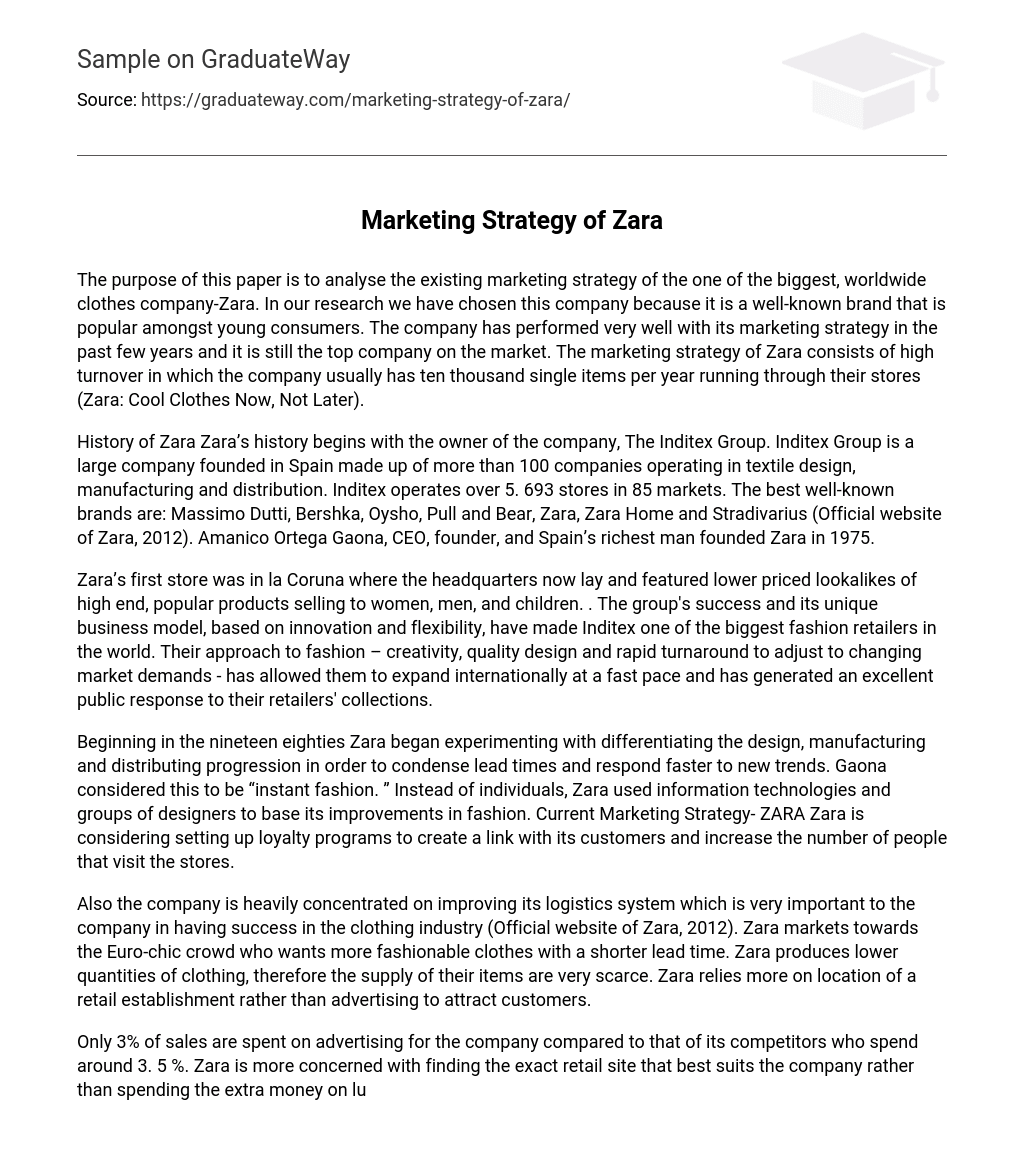The purpose of this paper is to analyse the existing marketing strategy of the one of the biggest, worldwide clothes company-Zara. In our research we have chosen this company because it is a well-known brand that is popular amongst young consumers. The company has performed very well with its marketing strategy in the past few years and it is still the top company on the market. The marketing strategy of Zara consists of high turnover in which the company usually has ten thousand single items per year running through their stores (Zara: Cool Clothes Now, Not Later).
History of Zara Zara’s history begins with the owner of the company, The Inditex Group. Inditex Group is a large company founded in Spain made up of more than 100 companies operating in textile design, manufacturing and distribution. Inditex operates over 5. 693 stores in 85 markets. The best well-known brands are: Massimo Dutti, Bershka, Oysho, Pull and Bear, Zara, Zara Home and Stradivarius (Official website of Zara, 2012). Amanico Ortega Gaona, CEO, founder, and Spain’s richest man founded Zara in 1975.
Zara’s first store was in la Coruna where the headquarters now lay and featured lower priced lookalikes of high end, popular products selling to women, men, and children. . The group’s success and its unique business model, based on innovation and flexibility, have made Inditex one of the biggest fashion retailers in the world. Their approach to fashion – creativity, quality design and rapid turnaround to adjust to changing market demands – has allowed them to expand internationally at a fast pace and has generated an excellent public response to their retailers’ collections.
Beginning in the nineteen eighties Zara began experimenting with differentiating the design, manufacturing and distributing progression in order to condense lead times and respond faster to new trends. Gaona considered this to be “instant fashion. ” Instead of individuals, Zara used information technologies and groups of designers to base its improvements in fashion. Current Marketing Strategy- ZARA Zara is considering setting up loyalty programs to create a link with its customers and increase the number of people that visit the stores.
Also the company is heavily concentrated on improving its logistics system which is very important to the company in having success in the clothing industry (Official website of Zara, 2012). Zara markets towards the Euro-chic crowd who wants more fashionable clothes with a shorter lead time. Zara produces lower quantities of clothing, therefore the supply of their items are very scarce. Zara relies more on location of a retail establishment rather than advertising to attract customers.
Only 3% of sales are spent on advertising for the company compared to that of its competitors who spend around 3. 5 %. Zara is more concerned with finding the exact retail site that best suits the company rather than spending the extra money on luring customers into the store (A. Mazaira et al, 2003). Zara’s approach to design is closely linked to its customers. A non-stop flow of information from stores conveys shoppers’ desires and demands, inspiring our 200-person strong creative team.
Zara is in tune with its customers, who help it give shape to the ideas, trends and tastes developing in the world. This is the secret to its success among a wide range of people, cultures and generations, who, despite their differences, all share a special fondness for fashion. Strategic Marketing Objectives – increase customer satisfaction, decrease dissatisfaction of the plus size consumer – Increase purchase frequency among plus size customer – continue to grow by extending the Zara fashion brand Increase brand awareness and favorable attitudes among customers – affordable prices, good quality Zara marketing mix Product: Zara manufactures the products like clothes, shoes, cosmetics and accessories for men, children and women. Since 2011 products in all sizes. Annually Zara produces around 11000 different products. Price: “Reasonable” prices in order to ore people could afford Zara’s products. Place: Zara is present in almost 30 countries and this number growths. Promotion: Simple advertisements, mostly on the internet.
The company controls and monitors its brands strategically by keeping in view all the goals and objectives. Management is working properly with effective communication skills that added new business models in the company. References: 1. Official website of Zara. www. zara. com. Available on the 6th of December 2012 2. A. Mazaira, E. Gonzalez, R. Avendano, (2003) The role of market orientation on company performance through the development of sustainable competitive advantage: the Inditex-Zara case, Marketing Intelligence & Planning, Vol. 21 Iss: 4, pp. 220 – 229





